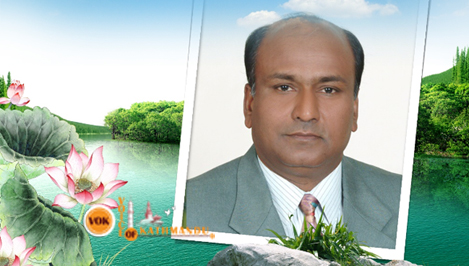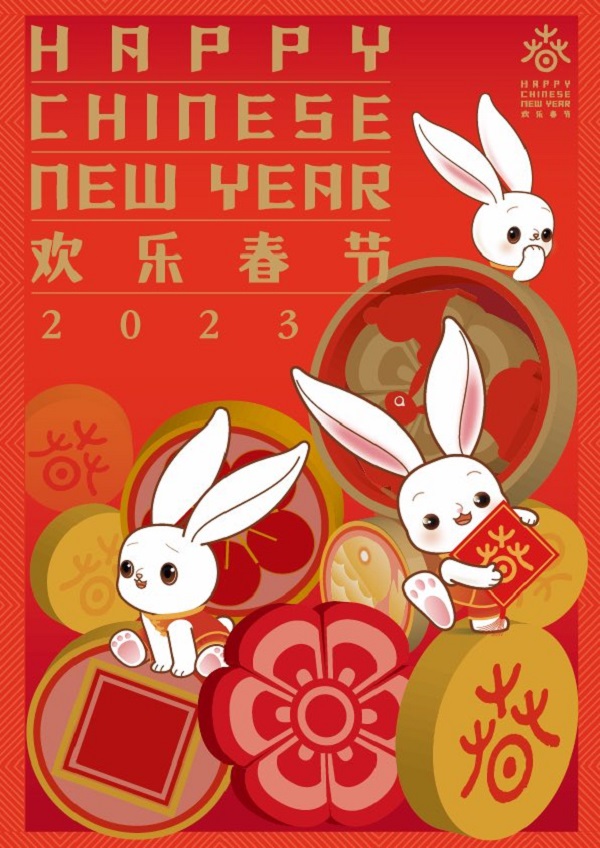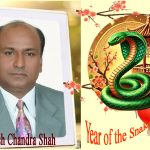The Chinese New Year-Rabbit Year
- Dr. Harish Chandra Shah

Kathmandu, 2023 January 16, Monday
 By Dr. Harish Chandra Shah
By Dr. Harish Chandra Shah
Nepal and China are connected by mountains and rivers. The friendship between Nepal and China has a very long history.
The two countries have always maintained a profound friendship and cooperative partnership, and are true friends who share weal and woe. Like Nepal, various traditional festivals are celebrated and observed in China. May be some of us have less knowledge about the Chinese festival and customs. Here I would like to give a brief introduction about Chinese spring festival and New Year.

In China, and the whole world where Chinese people live, each year when winter atitsend and spring around corner, people throughout China enthusiastically celebrate the first important traditional holiday of the year. Chinese people celebrate spring festival as a New Year by the lunar Calendar. Coming New Year is going to start from 22nd January 2023. According to Chinese lunar calendar, there are 12animals use to symbolize the Year in which a person is born. For example, Mouse,
Ox, Tiger, Rabbit, Dragon, Snake, Horse, Sheep, Monkey, Rooster, Dog, Pig. Next coming year is Rabbit year.
The sign of Rabbit is a symbol of longevity, peace, and prosperity in Chinese culture. 2023 is predicted to be a year of hope. The Chinese culture, the rabbit is known to be the luckiest out of all the twelve animals. It symbolizes mercy, elegance and beauty. People who are born in the year of the rabbit are calm and peaceful. They avoid fighting and arguing at all times, but are artistic and have good taste in life. The personality of Rabbits can be silly, timid, shy, curious, and high spirited regardless of sex or breed type. They show affection in characteristic ways; choosing to sit near you, climbing on your back or nibbling at your socks. Some will even lick your hand sor face.
Spring festival is China’s major traditional festival. Except spring festival, the lantern festival, pure Brightness Day, the dragon boat festival, the mid-autumn festival, and double ninth festival are celebrated as a major traditional festival with full of joyness and happiness. On the occasion of spring festival, Chinese people observe one-week national holidays starting from the first day of the New Year, people put on new clothes to visit relatives and friends and exchange greetings. On the second day, friends and relatives, visit each other with New Year cakes, orange crunchy candy as gifts. On the third day people just stay home and sweep clean their houses.
In the past, where the Chinese people used the lunar calendar, the spring festival was known as the “New Year”. It falls on the first day of the lunar month, the beginning of a New Year. After 19′ A.D. China adopted the Gregorian calendar to distinguish the lunar New Year from the New Year by Gregorian calendar, now the lunar New Year is called spring festival, which is generally celebrated in the last week of January and the mid-February. The last evening before the spring festival, the lunar New Year’s Eve is a very important time for family reunions. The Whole family gets together for a sumptuous dinner, followed by an evening of pleasant talk, games etc. Some families celebrate very likely with different cultural Programs staying up all night “Seeking the year out”. On this occasion, some go for marriage considering auspicious day. Go for long tour and some watch colorful T.V. Programs. The next morning, people use to pay their New Year greetings and wishes to their relatives and friends. They use to send and receive New Year and spring festival card. Now most of the city dwellers send greetings through WeChat and E-mail. During the New Year and spring festival various traditional and modern recreational activities are enjoyed in many Parts of China like lion dances, dragon lantern dances and boat rowing and stilt-walking. Firework is played to express joy and happiness during the spring festival and other auspicious occasions too. Fireworks playing is regarded as one China’s most important custom. Since several hundred years, the uses of spring festival couplets are still very popular in China. Spring festival Couplets are hung not only on the front of gates, but also, on the walls and beams and in setting rooms. Preparation for the New Year begins several days early when houses are thoroughly cleaned and new clothes purchased.
It is also traditional for every family to thoroughly clean their house, in order to sweep away any ill-fortune and to make way for incoming good luck. Another custom is the decoration of windows and doors with red paper cuts and couplets. Popular themes among these paper-cuts and couplets include that of good fortune or happiness, wealth, a nd longevity. Other activities include lighting firecrackers and giving money in red paper envelopes. For the northern regions of China, dumplings are featured prominently in meals
On New Year’s Eve, all the members of families come together for joint feast on thin occasion, JIAOZI-steamed dumplings are popular among Chinese people. JAOZI is much preferred the north, while a sticky Sweet glutinous rice pudding called NIAN GAO is preferred in South of China.
Guo Nian means passing the year is common term for wishing among the Chinese people for celebrating the spring festival. Chinese celebrate spring festival like X-mas for Americans and European and Dashain festival for Nepali.
In spite of heavy influence of western culture, Chinese people still celebrate and observe their various customs, festivals and activities accompanying traditional feast sand celebration with enthusiasm.
Note: (Dr. Harish Chandra Shah is a President of Nepal-China Cultural and Educational Council)










